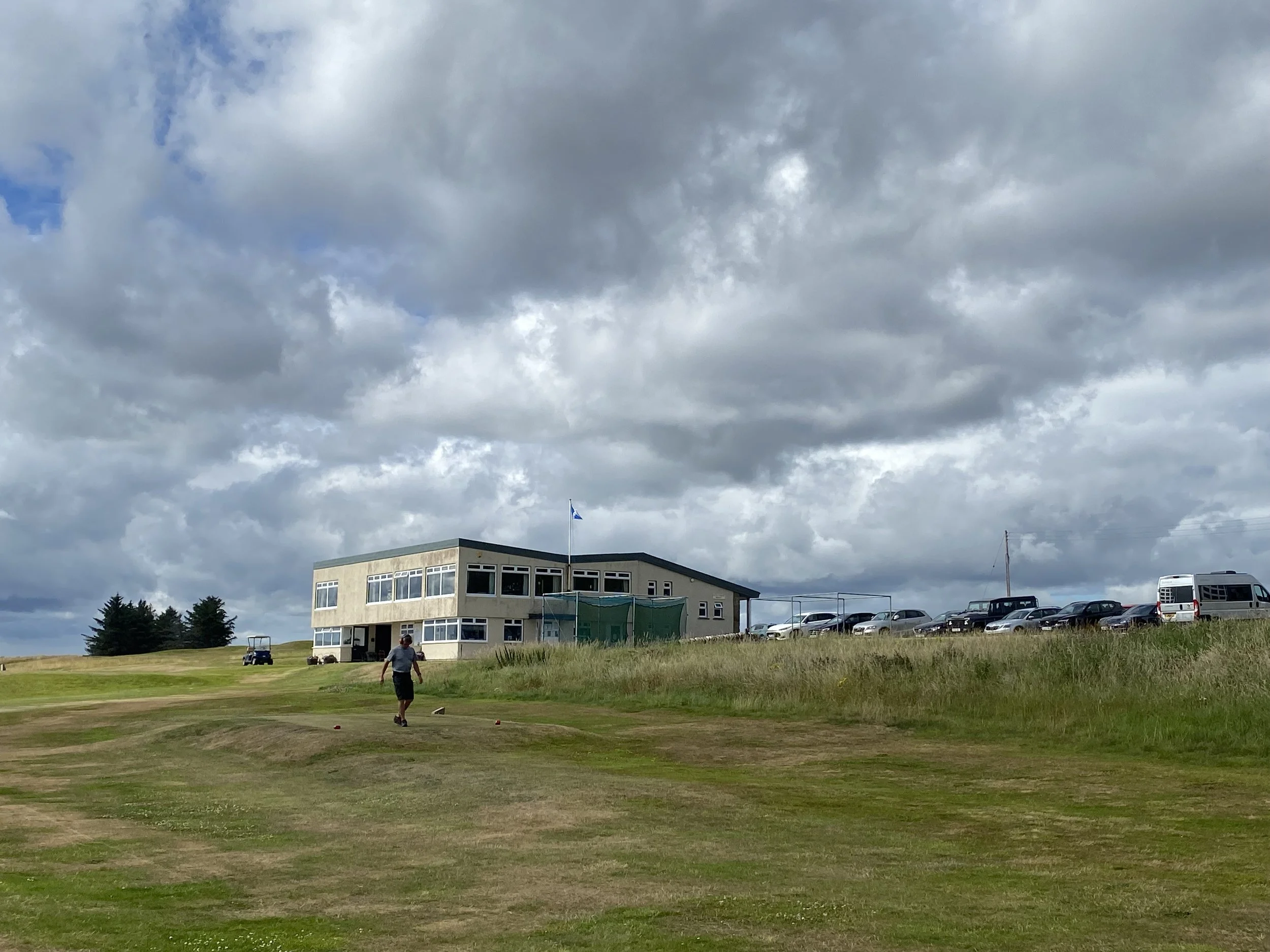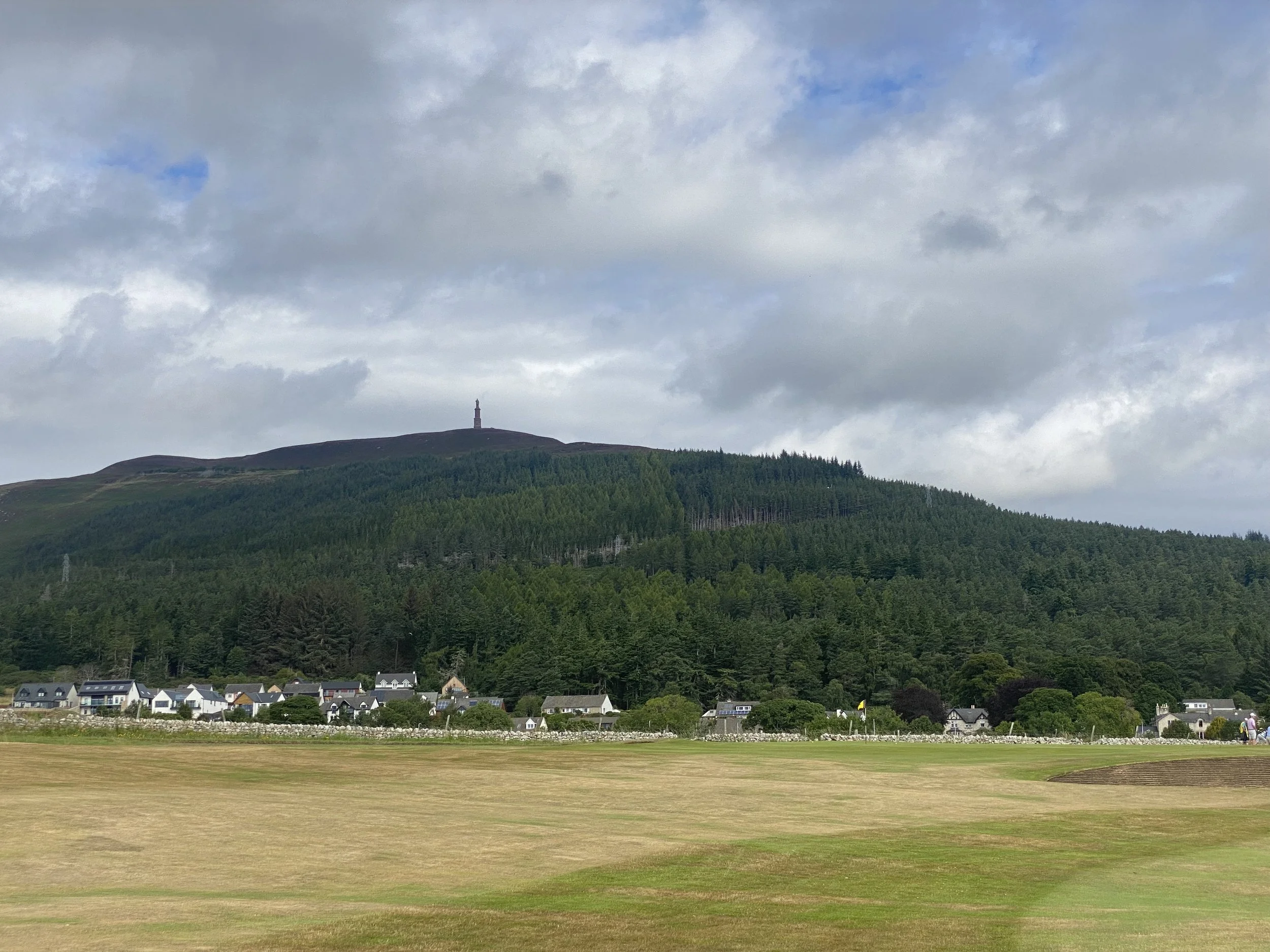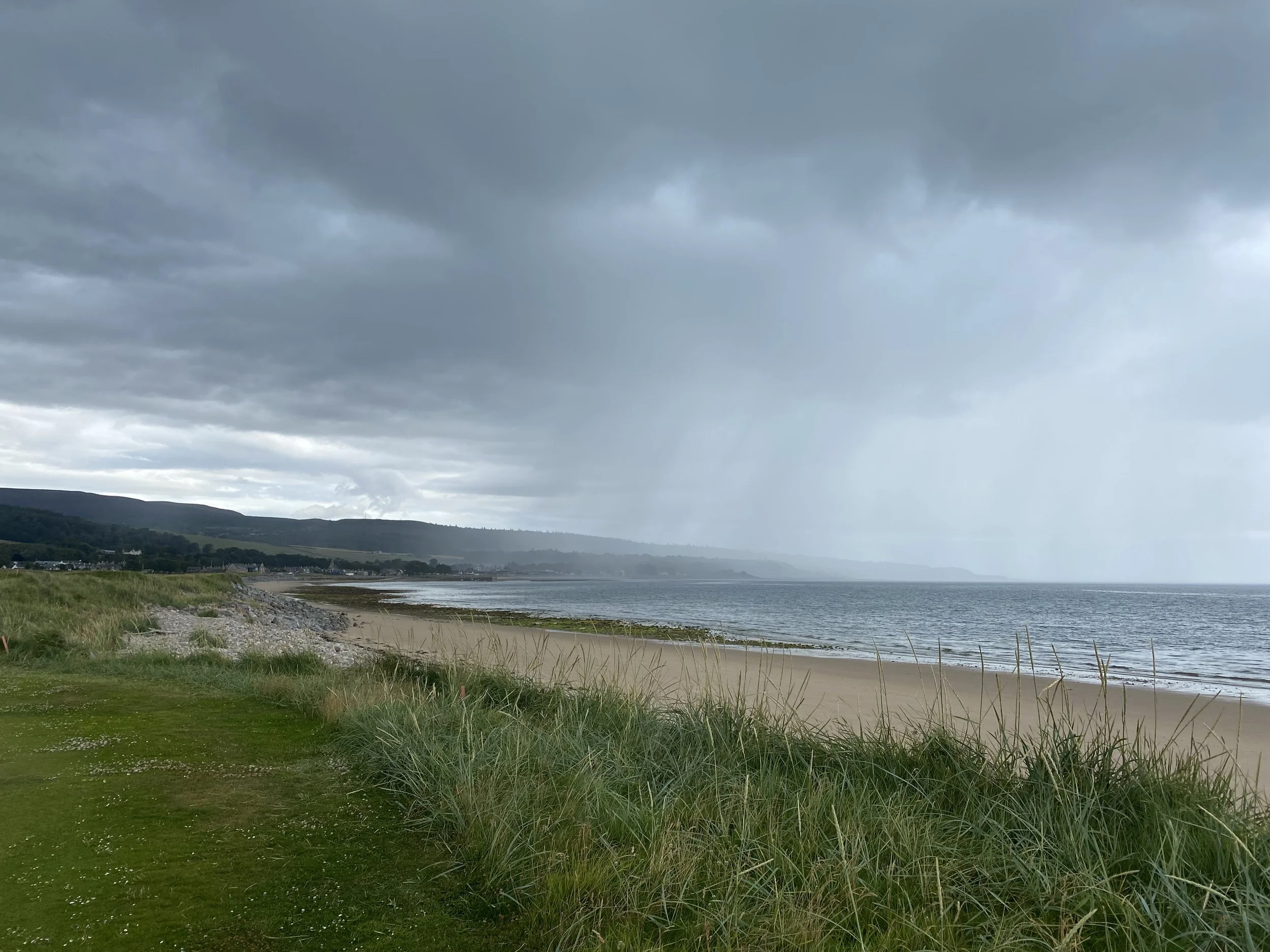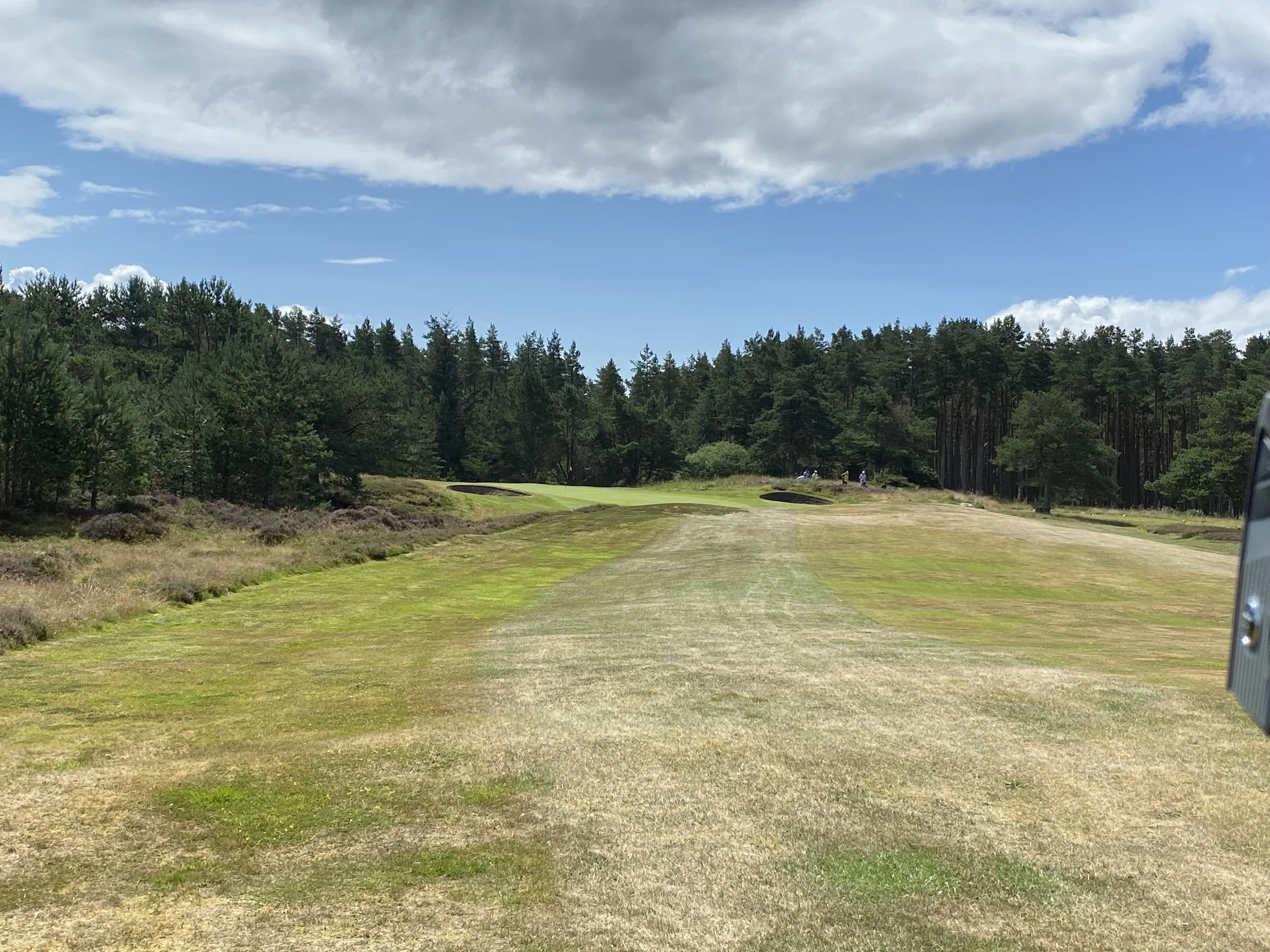Highland Fling: Golfing Adventure in Scotland – July 2025
Eight friends, all connected through our shared passion for golf and (mostly) members of Winged Foot Golf Club, traveled to the breathtaking Highlands of Scotland. This trip was the latest in a series of annual excursions, each destination offering its own unique charm and challenging courses: from my backyard of East Lothian’s “Golf Coast,” to the golf heritage of the Kingdom of Fife, and more recently the coastal beauty of Ayrshire in 2024, our travels have been filled with unforgettable experiences.
For our trip in July 2025, we ventured northwards, to tackle some of Scotland's most revered golf courses including iconic names like Royal Dornoch and (the) Nairn. Our journey would embrace the stunning landscapes and rich history of the counties of Sutherland, Ross and Cromarty, Inverness, and Nairn.
“Dornoch” in fact in Gaelic means “pebbly place”—not Pebble Beach—but apparently based on hand-sized stones that might have been used as weapons. The Castle and Cathedral were built in the 13th century. The town comprises some 1,500 people, and with the golf course so prominent and being a key point on the (North Coast 500) route, it’s perhaps no surprise that tourism is the largest business in the area.
The Dornoch area holds special memories for me as I recall family vacations spent camping on Embo beach during my childhood. Incredibly, the hotel/restaurant "Grannies Healan’ Hame” is still there!
The area is noteworthy also as the then Duke of Sutherland (Sutherland) initiated mass deportations by clearing the lands of farmers to be replaced by more profitable sheep. Many Scots emigrated from the mid-18th century to The States and Canada, as well as South America, Australia, and New Zealand—and their influence in the development of these countries has been impressive. In addition, the stage was set for the extension of British influence and the creation of the Empire, as French support for the Jacobite Charles Edward Stuart was curtailed. Culloden was also the last battle on British soil. The end of the fighting also encouraged the Scottish Enlightenment and the amazing outpouring of scientific and economic thinking and discovery. There’s a terrific book by Arthur Herman which details some of the impacts on modern society stemming from some amazing Scottish people from this period.
Ok, those days are over now and in the past they must remain—so what about this trip?
The Journey North:
My journey north began after The Scottish Open at Renaissance—where last year’s winner was Scotland’s own Bob McIntyre. A very popular winner, as you might imagine, who later made a significant contribution to the Ryder Cup win in Italy. This year, it was the relatively unknown Chris Gutterup who came out ahead of Rory McIlroy. Gutterup shot an incredible 61 in round two; he would finish third in The Open at Port Rush the following week.
More importantly, however, I left right after celebrating my twin granddaughters Maisie and Reagan’s second birthday party. There can be surely no better way to prepare for a golf trip than loading up on kids’ party food and being in the petri dish atmosphere with all those little guys running around with coughs and runny noses. All that gym work seen on “Full Swing” seems so overrated!
The 200-mile drive to Dornoch is superb. The route takes you across the (relatively new) majestic Forth Bridge and reveals Scotland's natural beauty through charming towns and the breathtaking vistas of the Spey Valley. From Edinburgh, it’s roughly 100 miles to where the Highlands begin, just after Pitlochry. A further 50 miles or so and you arrive in the Cairngorms, Scotland’s ski area, with places like Aviemore providing more marvelous scenic aspects to the trip.
The approach to Dornoch is particularly striking; you travel over three bridges—over the Moray Firth, next the Cromarty Firth, and finally the Dornoch Firth. I was very fortunate in that both the sun and the tides were out, highlighting the beauty of this part of the Scottish coastline.
You can fly into Inverness from London or the Continent or Dublin, but there is something awfully nice about that drive up through central Scotland. If you have the time, I might suggest it’s a pretty good way to get acclimatised to the country.
Golf Courses Played (and Rankings):
Royal Dornoch (4)
Cabot Highlands (8)
Nairn (20)
Brora (28)
Golspie (63)
Fortrose & Rosemarkie (70)
Tain (82)
Day Six: Golspie – Highland Variety with Authentic Charm
Day six brought us to Golspie Golf Club, one of the Highlands’ best-kept secrets. Founded in 1889, Golspie boasts a long and colourful history, growing from the local Sutherland Golfing Society’s early activities. Golf was played on these links before the club’s foundation—dating back to 1878—with the original nine-hole course opening in the 1890s and extended to 18 holes by 1905.
The renowned architect and golfer James Braid was invited in the 1920s to redesign significant portions of the course. His alterations, completed by 1927, remain the foundation of Golspie’s character today. Golspie is somewhat unique compared to typical Scottish links courses. Its layout combines a mixture of classic links, heathland, and parkland holes on a relatively compact 6,021-yard, par-70 course. This mixture offers diverse challenges and visually stunning surroundings, including sweeping views of the Dornoch Firth on one side and the rugged Ben Bhraggie hills on the other.
The course begins over heathland before transitioning to authentic links land adjacent to the coastline. Undulating fairways, deep bunkers, and challenging greens test every aspect of your game. I thought there were a number of really good holes. Hole 4 “Gully” is a par five skirting the edge of the beach, made memorable by both its beauty and tactical swale before the green. It’s astonishing to stand here and imagine the fairway submerged when storms breach the dunes—weather and the sea are forever co-authors of Scottish golf. The par 3 6th hole three nestles its green below gorse-clad dunes. Hole 14 (“Gully”) – A par five skirting the beach edge, notable for its tactical swale in front of the green and spectacular coastal views. Holes 16 and 17 – Back-to-back par threes, with the 16th (“Cairngorms”) requiring a precise tee shot to a two-tiered green, making club selection and shot execution critical. Hole 18 (“Drumbrae”) – A challenging finishing par four featuring a blind approach over a fairway mound, which would surely have delighted Old Tom Morris’s eye for course quirks.
Despite its modest length, Golspie demands focus, precision, and strategic thinking, especially given the frequent Highland winds. It is widely praised for some of the best greens in the Highlands, offering true rolling surfaces that reward good putting. Golspie’s reputation as a hidden gem is well-earned. It's consistently ranked among Scotland’s top 100 courses and provides a wonderful blend of authenticity, challenge, and natural beauty. For many visiting the Highlands, Golspie stands out as a highlight of the trip and deserves a higher profile than it currently holds.
The clubhouse offers excellent Highland hospitality with stunning vistas over the Moray Firth, a warm welcome, and the facilities to match the quality of the course.
Day One: Fortrose & Rosemarkie – A Storied Classic on the Chanonry Peninsula
The journey started at the historic Fortrose & Rosemarkie Golf Club, perched on the slender Chanonry Peninsula with sweeping vistas of the Moray Firth. A warm Highland welcome from club secretary Mike MacDonald—himself a symbol of the club’s storied lineage—set the perfect tone. The course, ranked as the 15th oldest club in the world with documented play since 1702, radiates authenticity. Reimagined by James Braid in 1932 and later honored as Scotland’s Best Golf Course/Venue (2024), its signature is a tapestry of narrow, gorse-flanked fairways, pot bunkers, and small, springy greens.
Playing here is to dance with the elements: the ever-present Scottish crosswinds test every shot while dolphins often grace the waters nearby. Despite its modest 6,085 yards, the course requests precision more than power—a challenge made friendlier by gentle hospitality and immaculate conditioning. Calm weather gifted us a benevolent day, but locals reminded us how brisk winds can render even short par threes into bruising tests. An ideal start—full of character, fun, and charm, and highly recommended for any Highland itinerary.
Day One (cont’d): Nairn – Championship Heritage by the Sea
“The Nairn” offers 130 years of championship tradition just 15 minutes from Inverness. Designed by legends like Old Tom Morris and James Braid, this course hosts the Walker and Curtis Cups among other storied tournaments. Nairn features out-and-back links routing, with the opening seven holes hugging a dramatic coastline—each shaped by undulating fairways, deep bunkers, and some of the most challenging green complexes in Scotland.
Standout holes include the coastal dogleg 3rd, the icehouse-framed 9th, and the majestic, elevated 14th. The sea looms as both beauty and hazard, its presence felt on nearly every shot. Facilities blend modern luxury with old-school tradition; from panoramic dining to a nine-hole warm-up course. The links demand accuracy and imagination, rewarding creative iron play and patience in the wind. A quintessential championship test—beautiful, historic, and immensely rewarding for all who venture north.
Day Two: Brora – Quirky Tradition Amid Highland Ruggedness
Brora is a paradox: an old-school links set in a town with a history of coal mining and electricity firsts. Designed by Braid in 1924 across 194 rugged acres, it delivers memorable coastal views—but also some unusual hazards. Sheep graze freely and low-voltage electric fences ring every green, keeping livestock (and maybe golfers) respectfully at bay.
The layout follows Kintradwell Bay outward, then returns along croft land with fairways that can be patchy or rough. The day’s wind brought a bracing Scottish test and enforced the need for local knowledge on blind approaches and sloped greens. Despite a friendly clubhouse, Brora’s challenging conditions—intrusive stock fences, unpredictable turf, severe slopes—made for a frustrating round. While some cherish its ramshackle charm, for me it was a test of patience more than of skill.
Day Three: Tain – Old Tom’s Northern Jewel
Historic Tain Golf Club comes framed by the gentle sweep of the Dornoch Firth, just 40 minutes north of Inverness. Designed in 1890 by Old Tom Morris, the course retains many original features and delivers a blend of links and heathland character. The routing begins gently but comes to life on the inward nine, especially the 11th hole “Alps” and the iconic 17th “Black Bridge”—one of Morris’s greatest par threes with a fairway-crossing river adding drama.
Course conditions were mixed: early holes suffered from wear, but the key stretches shone with variety and challenge. Evolving weather brought light winds and a sense of tranquility unique to this region, occasionally underlined by the roar of RAF jets from Lossiemouth overhead. Tain is high on local hospitality, big on history, and offers just enough golf drama to be a worthy Old Tom pilgrimage.
Day Four and Five: Royal Dornoch – The Crown Jewel
Playing Royal Dornoch is the golf trip’s high note—a spellbinding masterpiece regularly ranking among the best in the world. Its history runs deep: the current 18-hole design stems from Old Tom Morris and John Sutherland’s touch, with legends like Donald Ross and Tom Watson leaving their imprint on club lore.
Set across a sprawling links amphitheater with golden gorse and glinting firth waters, Dornoch’s holes all bring unique strategic charm—none more so than the signature “Foxy” (14th), a bunkerless par four demanding brilliance from tee to green. Sloping, elevated greens throughout challenge even the best short games. The course was in pristine condition and every shot was as inspiring as it was exacting.
A day at Dornoch is more than a round—it’s an immersion: history, camaraderie, and Highland hospitality interwoven in an unforgettable tapestry. For any golf lover, this is a pilgrimage to savor.
Day Seven: Cabot Highlands – Modern Grandeur on the Moray Firth
The finale at Cabot Highlands (formerly Castle Stuart) delivered a stylish modern counterpoint to the ancient links. Designed by Hanse and Parsinen and opened in 2009, the course sprawls along the Moray Firth using elevation, dramatic mounding, and wide fairways to create both a spectacle and a welcoming layout for all handicaps.
Highlights abound: cliff-top tee shots, risk-reward options, and world-class short holes like the water-spanning 11th. Exceptional greens and clever routing ensure seclusion and visual drama on every swing. Clubhouse comfort and caddie service are exemplary—recalling hospitality as memorable as the golf itself. Plans for the Tom Doak-designed Old Petty course promise even more world-class golf soon.
Cabot Highlands is excellent, though purists may find its modernity less enchanting than the likes of Dornoch or Golspie. Still, its superb conditioning, beautiful setting, and accessibility make it an essential stop on any Highland golf trip.
Conclusion
The Highland experience is truly unforgettable. Royal Dornoch stands out and is a sensational course that should be on everyone’s bucket list; Tom Watson himself described it as a “natural masterpiece.” Beyond such a well-known course lie hidden gems such as Golspie and Fortrose that make for a really complete Scottish golfing experience.
Scotland’s golf regions each have their stars—Fife and St Andrews, East Lothian around Gullane, Ayrshire with Prestwick and Turnberry, and finally the Highlands, anchored by Royal Dornoch. A golfing trip through each area could easily take two delightful weeks.
Trip Organization & Practical Details
Dining Highlights
Dornoch Castle Hotel – The Vault
I managed to book The Vault, a wonderful private dining area housed in the former dungeon of the castle. It was the perfect setting to conduct our usual end-of-season awards ceremony. Although Ben H, who normally runs this tradition, missed the trip this year, we celebrated with multiple toasts in his honor. The Vault seats up to approximately 10 people. The service was excellent, and the food was superb: starting with a charcuterie board, followed by steak with vegetables, and finishing with a very nice dessert.
Highland Spice, Dornoch
Skeptical about non-city curry houses, I was pleasantly surprised by a hearty chicken tikka and fresh naan offered at reasonable prices.
Luigi’s, Dornoch
This cozy Italian restaurant impressed with a perfectly creamy burrata starter and a halibut main course that reflected a kitchen of high standards. Not cheap, but worth it for quality food and a good wine list.
Marine Hotel, Brora
Located just steps from the golf course, we dined here after a windswept round. The maître d’, a South African by way of Scotland, helped us navigate the menu. My ribeye steak was excellent, and the service matched the food. I would thoroughly recommend this hotel. Although I didn’t see the rooms, I expect them to match the high standard of the dining experience.
Nairn Golf Club
Set overlooking the 1st and 18th holes of the golf course, the club offers pleasant dining with quite good food. However, the service level could have been improved significantly.
Royal Dornoch Golf Club Clubhouse Dining
Offers informal dining with spectacular views overlooking the 1st Tee of the Championship Course and the Dornoch Firth. Their menu emphasizes locally sourced, freshly prepared dishes celebrating the Highland larder. Service could be better.
Trip Organization & Practical Details
Accommodation
We stayed in self-catering apartments at The Royal Dornoch Hotel. Amy, who was terrific, arranged most of the golf and accommodation for our group.
Each apartment comprised two bedrooms—one with an ensuite—and a large, open-plan kitchen, dining, and lounge area. They were very well appointed and equipped with modern appliances, including a washer-dryer, cooker, hob, fridge, and freezer. The generous living spaces were perfect for relaxing after a day on the links.
Booking through the Royal Dornoch Hotel was hassle-free, thanks to the cheerful and efficient staff who also reserved our tee times—a huge help.
While the apartments were excellent, the main hotel building itself showed signs of wear: chipped paint, tired wallpaper, and indifferent restaurant service somewhat detracted from the overall experience. For comfort and peace of mind on a golf trip, I would recommend choosing these apartments over the main hotel accommodations.The main hotel felt dated, with tired decor and average restaurant service, but the apartments were excellent.
Transport
Amy at the Royal Dornoch Hotel provided me with the contact details for David Purvis, and I would highly recommend his services.
David proved to be an incredibly reliable driver with excellent local knowledge. Always punctual, professional, and easy to communicate with, he made getting to and from the various courses and dining spots simple and stress-free.
Whether you're coordinating group travel, airport transfers, or day trips across the Highlands, David is a great choice for anyone visiting the area and wanting dependable, friendly transport services from a true local expert.
Planning Tools
Highland Golf was an outstanding resource describing nearly 30 courses.
VisitScotland has a helpful website that provides lots of useful information on the area, places to stay, and things to do. In fact, the history of the Highlands is pretty interesting, as events in the 18th century had global ramifications which influence us today. Within Scotland, the Clan system collapsed and the region saw the imposition of what is called “the clearances”—genocide in another way—after the Battle of Culloden in April 1746 ended the Jacobite rebellion. The House of Hanover—the current King’s family—was restored.
Slight Detours
For a fun morning or afternoon excursion, it’s possible to take a very small ferry from Nigg across to Cromarty. The ferry is tiny, so I would strongly advise not taking your car if it is an SUV or large vehicle, as you will have to reverse your vehicle off the ferry upon arrival.
Cromarty itself is a delightful little town with a charming array of restaurants, galleries, and shops. One highlight is Soutar Creek, which was closed when we visited but is reputedly well worth a visit. The harbor area is picturesque, and a very good coffee shop right at the waterfront provides a pleasant spot to relax and watch the boats.
If you find yourself in the Tain area, I recommend a visit to Tain Pottery, which produces absolutely beautiful pottery, showcasing local craftsmanship. Additionally, the nearby Glenmorangie Distillery offers fascinating tours. We enjoyed a very nice afternoon there—it’s a perfect way to experience one of Scotland’s famous whisky houses close to the golfing action.




